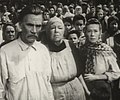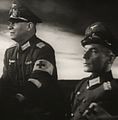The North Star (1943 film)
| The North Star | |
|---|---|
 Theatrical poster | |
| Directed by | Lewis Milestone |
| Written by | Lillian Hellman (story and screenplay) |
| Produced by | Samuel Goldwyn William Cameron Menzies |
| Starring | Anne Baxter Dana Andrews Walter Huston Walter Brennan Erich von Stroheim |
| Cinematography | James Wong Howe |
| Edited by | Daniel Mandell |
| Music by | Aaron Copland |
Production company | |
| Distributed by | RKO Radio Pictures |
Release date |
|
Running time | 108 minutes |
| Country | United States |
| Language | English |
| Box office | $2.8 million (US rentals)[1] |
The North Star (also known as Armored Attack in the US) is a 1943 anti-war film produced by Samuel Goldwyn Productions and distributed by RKO Radio Pictures. It was directed by Lewis Milestone, written by Lillian Hellman and featured production design by William Cameron Menzies. The film starred Anne Baxter, Dana Andrews, Walter Huston, Walter Brennan and Erich von Stroheim. The music was written by Aaron Copland, the lyrics by Ira Gershwin, and the cinematography was by James Wong Howe. The film also marked the debut of Farley Granger.
The film is about the resistance of Ukrainian villagers, through guerrilla tactics, against the German invaders of the Ukrainian SSR. The film was an unabashedly pro-Soviet propaganda film at the height of the war.[2]
In the 1950s, it was criticized for this reason and it was re-cut to remove the idealized portrayal of Soviet collective farms at the beginning and to include references to the Hungarian Uprising of 1956.[2] The film was released to American television where it was retitled Armored Attack with the film starting with the arrival of the Germans in the town and ended with scenes of the uprising.
Plot[]

In June 1941, Ukrainian villagers are living in peace. As the school year ends, a group of friends decide to travel to Kiev for a holiday. To their horror, they find themselves attacked by German aircraft, part of the Nazi invasion of the Soviet Union. Eventually their village itself is occupied by the Nazis. Meanwhile, men and women take to the hills to form partisan militias.
The full brutality of the Nazis is revealed when the Germans send Dr. von Harden to use the village children as a source of blood for transfusions into wounded German soldiers. Some children lose so much blood that they die. When Dr. Pavel Kurin, a famous Russian doctor, discovers this and informs the partisans, they prepare to strike back. They launch a cavalry assault on the village to rescue the children. The Russian doctor accuses the German doctor of being worse than the convinced Nazis, because he has used his skills to support them. He then shoots him. The peasants join together, and one girl envisions a future in which they will "make a free world for all men".
Cast[]
- Anne Baxter as Marina Pavlova
- Dana Andrews as Kolya Simonov
- Walter Huston as Dr. Pavel Grigorich Kurin
- Walter Brennan as Karp
- Ann Harding as Sophia Pavlova
- Jane Withers as Clavdia Kurina
- Farley Granger as Damian Simonov
- Erich von Stroheim as Dr. von Harden
- Dean Jagger as Rodion Pavlov
- Carl Benton Reid as Boris Stepanich Simonov
- Ann Carter as Olga Pavlova
- Esther Dale as Anna
- Ruth Nelson as Nadya Simonova
- Paul Guilfoyle as Iakin
- Martin Kosleck as Dr. Richter
- Robert Lowery as Russian gunner
- Grace Cunard as Farmer's wife

Walter Huston, Esther Dale & Ruth Nelson

Erich von Stroheim & Martin Kosleck

Carl Benton Reid

Ann Harding
Criticism[]
The House Committee on Un-American Activities would later cite The North Star as one of the three noted examples of pro-Soviet works made by Hollywood, the other two being Warner Brothers' Mission to Moscow (1943) and MGM's Song of Russia (1944).[3] Similar U.S. World War II movies are RKO Radio Pictures's Days of Glory on Russian resistance in the Tula Oblast and MGM's Dragon Seed on Chinese efforts against the Japanese occupation.[4]
The extent to which the film incorporated official Soviet propaganda about collective farms prompted British anti-communist writer Robert Conquest, a member of the British Foreign Office's Information Research Department (an anti-communist propaganda unit)[5] in the 1950s, to later write "a travesty greater than could have been shown on Soviet screens to audiences used to lies, but experienced in [collective-farm conditions] to a degree requiring at least a minimum of restraint".[6]
Recut[]
The film was rereleased in 1957 under the title Armored Attack. This edited version opens with the entry of a German column marching into a village and concludes with narration praising the Hungarian Uprising of 1956. It was released together with Fred Zinnemann's 1953 film The Men which was also renamed to Battle Stripe.[7]
In later years, the original version was made available on home video restoring segments removed for the 1957 re-release.[8]
Awards[]
The film was nominated for six Academy Awards:[9]
- Art Direction (Black-and-White) (Perry Ferguson, Howard Bristol)
- Cinematography (Black-and-White) (James Wong Howe)
- Music (Music Score of a Dramatic or Comedy Picture) (Aaron Copland)
- Sound Recording (Thomas T. Moulton)
- Special Effects (Clarence Slifer, Ray Binger, Thomas T. Moulton)
- Writing (Original Screenplay) (Lillian Hellman)
References[]
- ^ Variety (21 February 2018). "Variety (January 1944)". New York, NY: Variety Publishing Company – via Internet Archive.
- ^ a b "The North Star (1943) - Notes - TCM.com".
- ^ Murphy, Brenda (1999). "Congressional Theatre" (PDF). catdir.loc.gov. University of Cambridge.
- ^ "World War II: Soviet and Japanese Forces Battle at Khalkhin Gol - HistoryNet". 12 June 2006.
- ^ "Foreign Office's covert propaganda, Guardian 27 Jan 1978".
- ^ The Harvest of Sorrow: Soviet Collectivization and the Terror Famine, Conquest, page 321, Oxford Press, 1986; see Chapter 17 for detailed information on the efforts of pro-Soviet Westerns to help the regime cover up the true conditions on the collective farms.
- ^ Hollinger, Hy (March 26, 1958). "Film Reissues Need Prestige". Variety. p. 7. Retrieved October 11, 2021 – via Archive.org.
- ^ "Turner Classic Movies - TCM.com".
- ^ "The 16th Academy Awards (1944) Nominees and Winners". oscars.org. Retrieved 2011-08-14.
External links[]
| Wikimedia Commons has media related to The North Star (1943 film). |
- The North Star at IMDb

- The North Star at AllMovie

- The North Star at the TCM Movie Database

- The North Star at the American Film Institute Catalog

- The North Star at Box Office Mojo

- The North Star is available for free download at the Internet Archive
- 1943 films
- English-language films
- 1940s war films
- American films
- American pro-Soviet propaganda films
- American black-and-white films
- Eastern Front of World War II films
- Films set in Ukraine
- Films directed by Lewis Milestone
- Films about the Soviet Union in the Stalin era
- Samuel Goldwyn Productions films
- Films with screenplays by Lillian Hellman
- Films scored by Aaron Copland
- American war films



